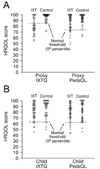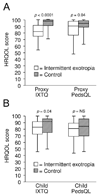Comparison of quality-of-life instruments in childhood intermittent exotropia
- PMID: 20417138
- PMCID: PMC2925436
- DOI: 10.1016/j.jaapos.2010.01.011
Comparison of quality-of-life instruments in childhood intermittent exotropia
Abstract
Purpose: To compare 2 health-related quality-of-life (HRQOL) instruments: the condition-specific Intermittent Exotropia Questionnaire (IXTQ) and the generic Pediatric Quality of Life Inventory (PedsQL) in children with intermittent exotropia.
Methods: Fifty-one children with intermittent exotropia (median, 7 years; range, 5-16 years) were recruited from outpatient clinics with one of their parents. All children completed age-appropriate Child IXTQ (12 items) and Child PedsQL (23 items). Parents completed parallel Proxy IXTQ and Proxy PedsQL (parent assessment of child's HRQOL). Possible scores ranged from 0 to 100 (worst to best HRQOL). Normal thresholds were defined using the 5th percentile in a control group of 47 normal nonstrabismic children. Proportions scoring below normal on each questionnaire were compared. Median scores in intermittent exotropia and control groups also were compared.
Results: More scores were subnormal using Proxy IXTQ than Proxy PedsQL (55% vs 18%, p = 0.0004). When Child questionnaires were used, we found that similar proportions scored below normal (IXTQ 8% vs PedsQL 14%, p = 0.3). Median scores were lower for intermittent exotropia children compared with control patients for Child IXTQ (83 vs 92; p = 0.04), Proxy IXTQ (81 vs 98; p < 0.0001), and Proxy PedsQL (p = 0.04) but not for Child PedsQL (p = 0.3).
Conclusions: The Proxy IXTQ detects reduced HRQOL related to intermittent exotropia more often than the Proxy PedsQL. There were few subnormal scores on Child IXTQ and Child PedsQL. Children with intermittent exotropia scored, on average, lower than control patients on the IXTQ, but most individual scores fell within the normal range. The IXTQ may prove useful for clinical assessment of intermittent exotropia.
Conflict of interest statement
None of the authors have any potential conflicts of interest to disclose.
Figures


References
-
- Varni JW, Seid M, Kurtin PS. PedsQL 4.0: Reliability and validity of the Pediatric Quality of Life Inventory version 4.0 generic core scales in healthy and patient populations. Med Care. 2001;39:800–812. - PubMed
Publication types
MeSH terms
Grants and funding
LinkOut - more resources
Full Text Sources

